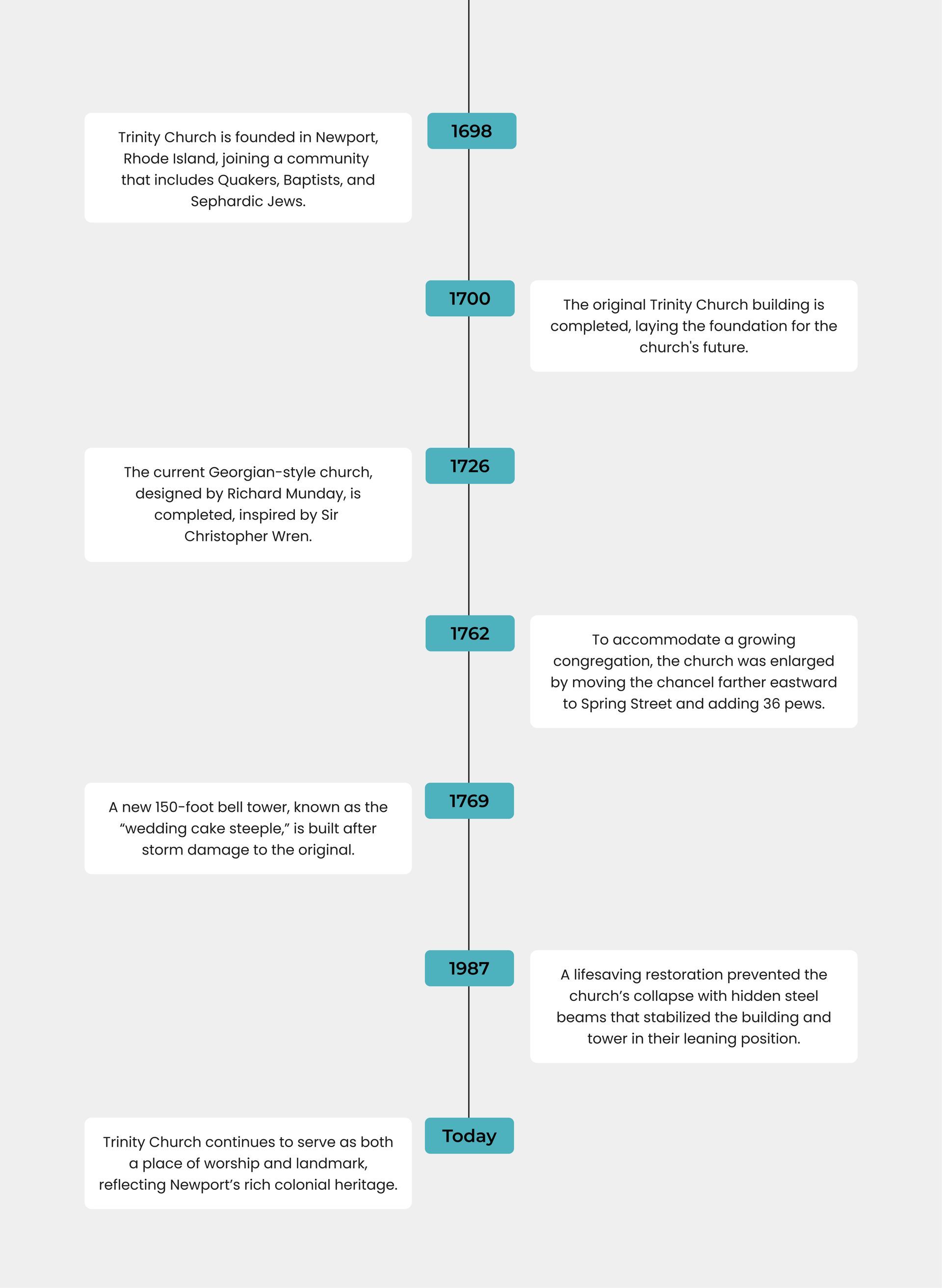The History of Trinity Church
A Timeless Landmark in Newport’s History
Trinity Church in Newport, Rhode Island, boasts a rich history that dates back to its founding in 1698. Established by a group of Anglicans seeking a place of worship in the American colonies, our Episcopal church has become a cornerstone of the community.
The current structure, completed in 1726, is an iconic example of Georgian architecture designed by Richard Munday. Notable for its wooden steeple and unique three-tiered pulpit, the church reflects the architectural style of its time.
Throughout the centuries, Trinity Church has been central to Newport's religious and community life, welcoming distinguished visitors such as George Washington and Queen Elizabeth II.
Today, it remains not only a place of worship but also a living testament to Newport’s colonial heritage and architectural legacy.
Trinity Church's Centuries
of Heritage
Trinity Church has deep roots in the community's religious and architectural history. Over the centuries, it has evolved in both structure and significance, serving as a place of worship and a symbol of the region's colonial heritage. Its long-standing presence has made it a cherished institution, embodying the resilience and continuity of the Newport community while adapting to the changing needs of its congregation.

Architectural Wonders of Trinity Church
Trinity is not just a place of worship but
a treasure trove of historical and architectural marvels.
Triple-Tiered
Wineglass Pulpit
Trinity Church is home to the only surviving three-tiered wineglass pulpit in the world. Centrally located in the aisle, this unique pulpit remains a focal point of the sanctuary, symbolizing the church’s historical emphasis on both preaching and the Eucharist.
Trinity’s First Organ
Trinity’s first organ, donated in 1733 by Rev’d Dr. George Berkeley and assembled by Charles Theodore Pachelbel, includes an original oak case that survived the Revolution. Many small-paned windows still feature their 18th-century wavy glass, enhancing the church’s historic charm.
The Chancel and Altar
The chancel features original 1728 panels displaying The Lord’s Prayer, Ten Commandments, and Apostles’ Creed. The altar, bathed in natural light from fisheye windows, includes historic communion silver, still used in special services today.
Church Windows
and Memorials
Trinity Church’s windows include 18th-century original glass and Victorian memorials, with notable works by Clayton and Bell and Louis Comfort Tiffany. The church also features memorial plaques honoring founders, military heroes, and figures like naval heroes Oliver Hazard Perry and Matthew Calbraith Perry, who were baptized here.
Candle-lit Chandeliers
Four brass chandeliers light the sanctuary, with the oldest dating back to 1728. These chandeliers, along with gilded ceiling medallions, reflect the church’s rich colonial heritage.
Box Pews
The wooden box pews provided warmth and comfort in colonial times and were a significant source of income for the church. Some pews, like Pew 1 (owned by the church’s builder) and Pew 81 (the “Distinguished Visitor’s” pew), hold historical significance. Today, all pews are open for visitors and members alike.
Notable Visitors
- George Washington – First President of the United States and a key figure in American history.
- Queen Elizabeth II – Monarch of the United Kingdom who visited during the U.S. Bicentennial celebrations.
- Princess Margaret – Sister of Queen Elizabeth II, known for her royal duties and public service.
- Archbishop Desmond Tutu – South African Anglican bishop and social rights activist.
- Three U.S. Presidents – Various American presidents who have honored the church with their visits.
- Comte de Rochambeau – French general who played a major role in the American Revolutionary War.
- The Chevalier de Ternay – French admiral who led troops to Newport during the American Revolution.
- Louis XVI of France – Although not a visitor, he sent a monument in honor of the Chevalier de Ternay, reflecting the church's connection to significant historical figures.
Experience Trinity's History Firsthand
Whether you’re a history enthusiast, an architecture lover, or simply seeking a moment of reflection, Trinity Church offers a unique glimpse into Newport’s rich heritage.

